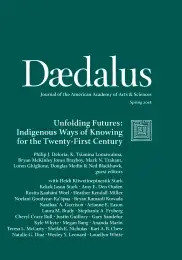Recognition, Antiracism & Indigenous Futures: A View from Connecticut
This essay is offered as a tribute to Golden Hill Paugussett Chief Big Eagle and his defiance of the entrenched racism to which his tribal community has been subjected. I situate this analysis in Connecticut in the early 1970s at a moment of particular historical significance in tribal nations’ centuries-long struggles to assert their sovereignty, defend reservation lands, and ensure their futures. I analyze how the racialization of Native peoples in Connecticut informed the state’s management of “Indian affairs” in this period and argue that the virulent racism of the state’s antirecognition policy in the late twentieth century reflects a long history of institutionally embedded racist policies and practices. In this essay, I call for politically engaged, antiracist research that is concerned with understanding the complexities of tribal sovereignty asserted in local contexts in which governmental control of Indian affairs reproduces and validates White-supremacist ideology.
Chief Big Eagle (Aurelius H. Piper, Sr.) died in August of 2008 on the one-quarter-acre reservation of the Golden Hill Paugussett Tribe in Trumbull, Connecticut. He was ninety-two and had been the Paugussetts’ hereditary tribal leader for over four decades. Those who knew him likely remember him as a force for justice who spoke in unvarnished terms about Native people’s everyday experiences of oppression and racism in Connecticut.1 His fight for the future of his tribal nation drew broad public attention in the mid-1970s, well before federal acknowledgment petitions and tribally owned casinos became the focus of racist hostility in southern New England.2 In March 1974, The New York Times published an interview with Chief Big Eagle entitled “Connecticut Indians Act to Reclaim Reservation,” which detailed the Paugussetts’ legal effort to reclaim nineteen and three-fourths acres of historical reservation land of which they had been wrongfully dispossessed. Those among the Times’ national readership who had followed media coverage of Indian activism at Alcatraz and Wounded Knee may not have imagined Connecticut as a site of Indian resistance (or even, perhaps, of living Indian people). Yet in this article, the Times directed wider public attention to the Chief of “the 100-member Golden Hill Tribe” defending “the nation’s smallest reservation,” and asserting the Tribe’s rights to other Paugussett ancestral lands.3 In their essential study of the Indian resistance movement of the 1960s and 1970s, Paul Chaat Smith and Robert Allen Warrior write that when Indians of All Tribes occupied Alcatraz Island in November of 1969, the press recognized it as “history in the making.” The Times depicted the Paugussetts’ land rights struggle in a similar light. Accompanying the article was a striking photograph of Chief Big Eagle sitting on a tree stump in front of the sole house on the reservation.4 Looking away from the camera, his hat resting on his knee and his arms folded, he appears relaxed, certain, and focused on the land.
This essay is offered as a tribute to the life of Chief Big Eagle and his leadership, particularly his defiance of the virulent racism to which his tribal community has been subjected. The cultural and political foundations of the idea of “race” are ancient, but the ways in which racial categories and racist practices have been bureaucratically produced and normalized in the modern era indicate that race remains central to governmental tactics of control. In this essay, racialization refers to the imposition of politically calculated and fictitious notions of racial identity on Native individuals and Native communities. Connecticut history stands as an archetypal example of this practice. “Indian Affairs”–the official government apparatus created primarily to manage Native peoples’ reservation lands and to administrate the state’s understanding of Indigenous issues–must be investigated as a domain of strategic racialization of Indianness and of the rights of tribal nations. The moment when Chief Big Eagle was interviewed by The New York Times in 1974 marked a crucial juncture in Paugussett tribal history and the state-tribal relationship in Connecticut. Chief Big Eagle, along with other tribal leaders and activists, directly and publicly challenged Connecticut’s twentieth-century governmental regime of Indian Affairs.
Racialization obscures and undermines the legal rights of Native peoples as well as their existence as sovereign political bodies.5 In Connecticut, racialization has presented tribal sovereignty as a threat and a fiction. For example, governmental scrutiny of tribal identities fosters White-supremacist notions of racial “illegitimacy,” which inform public assumptions about Indianness and the rights of tribes. Racialization operates in federal recognition struggles and is especially pernicious in its attacks on tribal communities whose members have African American ancestry. As Indigenous studies scholar Brian Klopotek has shown, “a complicated tangle of racial projects and colonialism [are] at work” in such cases, impacting tribal well-being and sometimes stoking racism within tribal communities themselves. Yet unfolding histories of tribal sovereignty in the United States also demonstrate the ways in which Native people have contested and exposed racialization projects.6
. . .
